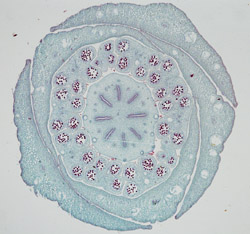Challenges of Working with Historical Anatomy Collections
Working with this historical collection presented many challenges because of its age, unique nature, and uncertainty on how the slides were originally prepared. Below are descriptions of some of the problems we encountered.
Broken slides
Remarkably few slides appear to have suffered physical damage, and most of those are minor chips and cracks along the edges. In a very few cases, we found cover slips beginning to detach from the slide, and in one case the cover slip fell off completely. Fortunately, there are protocols to replace cover slips that involves carefully re-heating the balsam mounting agent (we assume that Swingle used balsam, although we do not know for sure):
Hanson Pritchard, M. and G. O. W. Kruse. 1984. Making the best of things: reclaiming specimens. Systematic Parasitology 6: 253-255. <http://dx.doi.org/10.3732/ajb.0800341>
Mold
All of the slides in the collection are covered with a sticky substance, which under the microscope appears to be fungal hyphae, or mold. As far as we know, this collection has been stored in an air-conditioned building since the 1960s, when Cox Science Center was built. Apparently, 40 years of air conditioning is no match for mold in Miami.
 |  |
| A slide with mold | With mold removed |
Cleaning slides
We considered several methods of cleaning the slides of mold, dust, and grime, that would be least likely to dissolve the mounting agent, scratch or leave a residue on the glass of the slides. We finally settled on gently washing the slides by hand with tap water and Alconox. We have not seen evidence that this process damages the slides.
Fading and discoloration of slides
Many slides appear to be faded. However, different kinds of cells and tissues can often be discerned in even the most faded slides. We are currently exploring methods of restaining slides to restore their original bright colors. Some slides appear to have retained their (presumably original) bright colors better than others. This may be due to the kind of plant used in the specimen: most slides of bamboo, for example, still appear well stained, with different cell types showing contrasting colors. Other variation in the extent of fading may be due to the kind of structures sectioned (for example, lipids on epidermal cells appear to retain their red stain well), the thickness of the sections, amount of mounting agent used, or differences in their original preparation that we have yet to discover.
 | |
| Example of a faded slide |
A few slides show strikingly different coloration than the rest, with brilliant almost metallic blues, greens, and reds. These appear to be from dried and pressed herbarium specimens that were already "historical" in Swingle's day. Swingle and his staff adapted a method developed by Professor Juel, of Sweden, of removing then rehydrating small parts of these archival museum specimens. This allowed Swingle to include in his studies an astounding number of rare and significant species that are still not easily obtainable today.
 | |
| Limonia acidissima, from 1769 |
The oldest material used by Swingle dates to 1769 and are flower buds removed from an herbarium specimen of Limonia acidissima, collected by D. Pradier from "Mocka." We suspect that Mocka refers to Mocha, a port city now in Yemen that was an important stopover for French ships in the 18th century traveling between Europe and India, where this species grows naturally. Other relatives of citrus were cultivated in Yemen and the country is known for growing and trading coffee (mocha) and other plant products. We suspect that this specimen of L. acidissima was cultivated as well."
Prepared by Barbara Whitlock (2009-08-25)





